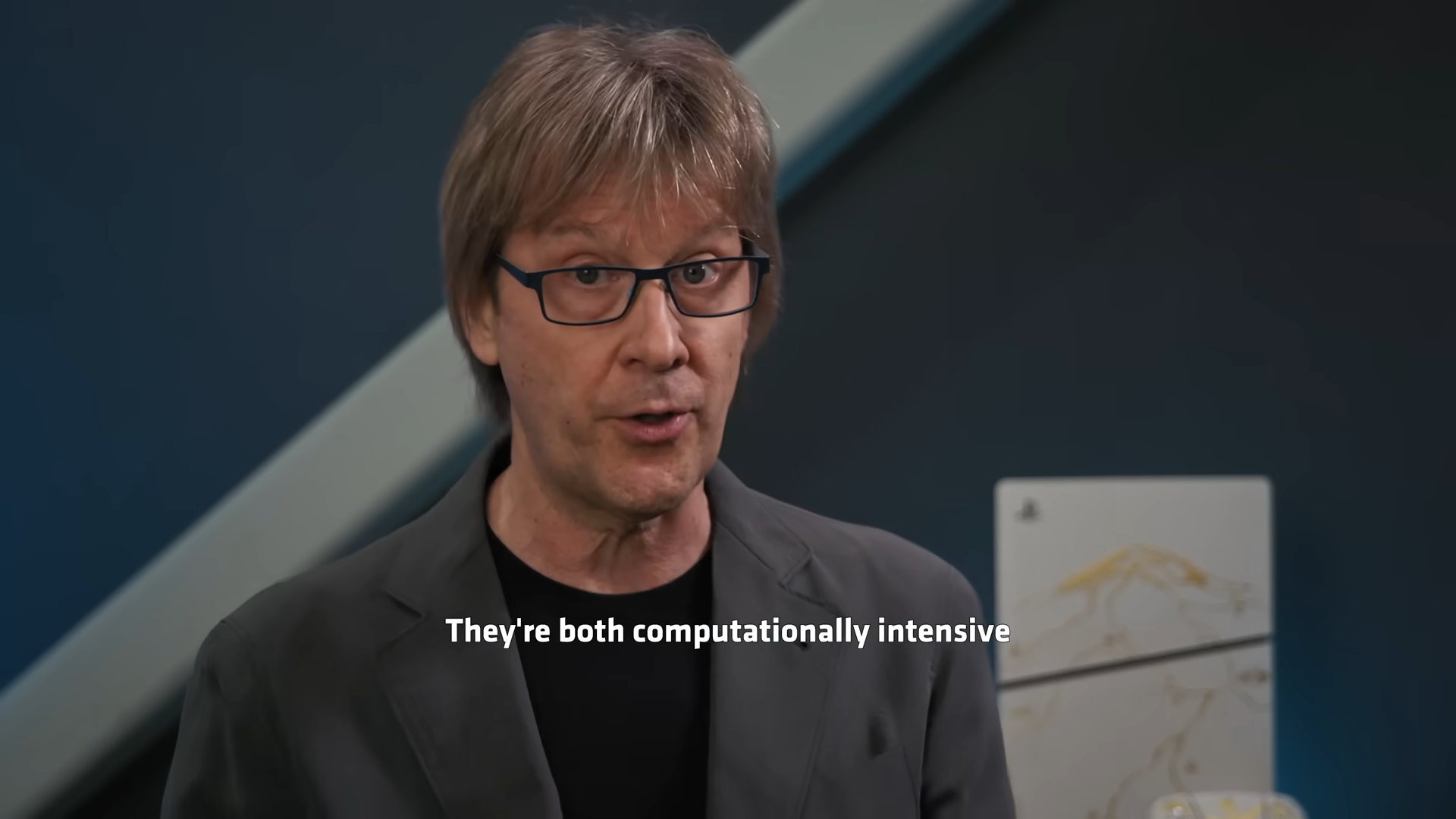Sony and AMD tease likely PlayStation 6 GPU upgrades —Radiance Cores and a new interconnect for boosting AI rendering performance

Sony is finally spilling the beans on some of the hardware upgrades it will be bringing to its next-generation console. AMD's senior VP and general manager of computing and graphics at AMD, Jack Huynh, and Sony's PS5 Lead Architect, Mark Cerny, published a collaborative video discussing new technologies that are being worked on as part of their collaboration, Project Amethyst. Some of these technologies include massive upgrades to AI rendering and ray tracing performance. The new hardware is likely to be part of the PlayStation 6, or possibly a handheld option.
Most of the nine-minute video discussed two new technologies that the two companies are working on together: Neural Arrays and Radiance Cores. Neural Arrays represent an optimization toward the AI-accelerators housed in each compute unit of AMD's modern RDNA architectures, which will network all of the CUs together.

This feature will reportedly allow a GPU to process a "large chunk of the screen in one go". The duo didn't go into significant detail about the new technology, but on the surface, Neural Arrays appears to be an "Infinity Fabric" style interconnect that will connect every single compute unit together and allow each compute unit to talk to each other directly without spilling out to cache.
One interesting tidbit is that this feature appears to be targeted exclusively toward improving AI-rendering performance, despite the fact that Neural Arrays apparently connects the entirety of each compute unit together (not just the AI portions of the CU).
Radiance Cores represent a new dedicated hardware block on a GPU that will reportedly speed up ray-traced rendering significantly and make real-time path-tracing possible. Radiance Cores takes the ray transversal part of the ray tracing pipeline and takes full control of it, processing it independently of the shader cores to speed up rendering time.
Memory compression is also getting a big upgrade; AMD and Sony are moving to a new technology called Universal Compression that allows all data types to be compressed "whenever possible". This is a big change from the PS5 series' outgoing compression implementation (Delta Color Compression), which can allegedly only compress certain data elements, including textures and render targets.
The introduction of these technologies, particularly Neural Arrays and Radiance Cores, shows that the next-generation Sony console (probably the PS6) will be designed to play ray-traced and path-traced games with equivalent performance to PC graphics card hardware that we have today. Cerny and Huynh also all but confirmed that the next-gen console will take full advantage of FSR Redstone and its suite of machine learning features.
Get Tom's Hardware's best news and in-depth reviews, straight to your inbox.
The PS5 and PS5 Pro technically have ray-tracing capabilities, but they are noticeably worse than what Nvidia or even AMD's latest GPUs are capable of (especially relating to the vanilla PS5). If you haven't caught on by now, Project Amethyst is the codename for Sony's next-generation console, which will likely be the PS6, but it could potentially include a handheld counterpart as well, as some outlets have speculated.
Arguably, the best part is that we can expect all of these technologies to make their way into future AMD graphics cards. Jack Huynh confirmed that the Universal Compression tech will be coming to future AMD SoCs and GPUs. Mark Cerny has also played a role in developing RDNA 5, so it is almost inevitable that Radiance Cores and Neural Arrays will be debuting in AMD's next-generation gaming GPU architecture.
Cerny also took a brief moment to tease the timeline of Project Amethyst, noting that these technologies will come to a "future console in a few years' time".
Follow Tom's Hardware on Google News, or add us as a preferred source, to get our up-to-date news, analysis, and reviews in your feeds. Make sure to click the Follow button!

Aaron Klotz is a contributing writer for Tom’s Hardware, covering news related to computer hardware such as CPUs, and graphics cards.
-
George³ Replywill come to a "future console in a few years' time".
Hmm, "few" means more than 2, usually. 2028? -
Heat_Fan89 Who would buy a Sony handheld after they dropped support for the overpriced PS Vita which was a very nice handheld btw, after a couple of years.?Reply -
Notton PS: 1995Reply
PS One: 2000
PS2: 2000
PS2 Slim: 2004
PSP: 2005
PS3: 2006
PS3 Slim: 2009
PS Vita: 2012
PS3 Super Slim: 2012
PS4: 2013
PS4 Slim: 2016
PS4 Pro: 2016
PS5: 2020
PS5 Slim: 2023
PS5 Pro: 2024
Going off of the rumor mill, PS6 is unlikely to come any sooner than 2027/Q2, when AMD launches RDNA5.
AMD cooked up a new way to do chiplets and streamline production between custom designs and their own. -
Amdlova Why on the Earth need a new system if the old ones (ps5) don't have a F game?Reply
Only way to next gen survive it's make compatible with steam, gog or other thing.
I have a PS3 Super Slim and a Nitendo Switch Japan day one. Still kicking at this day and Have tons of Games (good games). -
-Fran- This is a shot across the bow towards Microsoft.Reply
Why? Well, Microsoft has a history of screwing over AMD. Over... And over... And over. Since Microsoft's pushing the XBox buttons now, I'm guessing AMD is rather nervous about that? Perhaps I'm reading too much into this as usual. I can't help but think it's both Sony boasting and AMD making it clear to Microsoft they'll lose the XBox market if they don't stick to it.
Still, for all I dislike Sony, I can't say they suck at creating interesting stuff.
Regards. -
usertests Reply
X_pjrZQDerw-Fran- said:Why? Well, Microsoft has a history of screwing over AMD. Over... And over... And over. Since Microsoft's pushing the XBox buttons now, I'm guessing AMD is rather nervous about that? Perhaps I'm reading too much into this as usual. I can't help but think it's both Sony boasting and AMD making it clear to Microsoft they'll lose the XBox market if they don't stick to it. -
ekio I hope they will opt in for ARM CPUs for the upcoming SoCs, they are much better than x86 in single thread power, much better with heating and power consumption.Reply
Why should we stick with the x86 garbage for 10 more years when obvious superior solutions are here ? -
TerryLaze Reply
They already tried that, the ps3 and xbox360 were the consoles with the worst cases of overheating ever...ekio said:I hope they will opt in for ARM CPUs for the upcoming SoCs, they are much better than x86 in single thread power, much better with heating and power consumption.
Why should we stick with the x86 garbage for 10 more years when obvious superior solutions are here ?
Also it's very hard to code for and they would have to use a gpu from AMD anyway (or nvidia but good luck with that) so it makes much more sense to just use one chip from AMD. -
hotaru251 so tl;dr priority focus on moar ai features.Reply
which means gaming in general is goign downhill as we know industry of gaming is dictated by console and those bleed into pc ports.
means reliance on up scaling and framegen ignoring every downside they have because "lul number go up" -
thesyndrome Reply
Leakers like MLiD and Redgamingtech usually over-exaggerate upcoming hardware releases because it gets them views, which gets them paid.usertests said:X_pjrZQDerw
Like their claims that "Blackwell will be a Pascal-level improvement over Ada Lovelace" back in 2023/24, or that "AMD's upcoming graphics cards (9070XT) will compete with the 4090".
Take what they claim with a grain of salt, because often the actual hardware comes nowhere CLOSE to what they claim in the leaks.